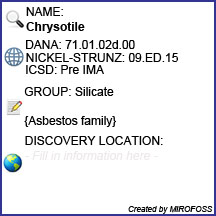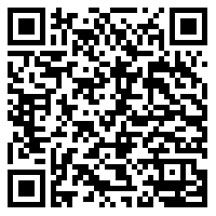

| Mineral Name | Chrysotile |
| First Discovered | 1834 |
| Nickel-Strunz Classification | 09.ED.15 |
| Dana Classification | 71.01.02d.00 |
| ICSD | Pre IMA |
| Mineral Group | Silicates |


| Cleavage | None |
| Colour(s) | Green, Yellowish green, White |
| Specific Gravity | 2.53 |
| Diaphaneity | Translucent |
| Fracture | Sectile |
| Mohs Hardness | 2.5 |
| Luminescence | Non-fluorescent |
| Luster | Silky |
| Streak | White |
| Habit(s) | Acicular |
| Radioactivity | Non-radioactive |
| Magnetism | Non-magnetic |

The following health hazards should be noted when handling chrysotile
 |
BIOHAZARD Chrysotile can cause asbestosis, lung cancer, and both pleural and peritoneal mesothelioma. |

The following image shows the elemental breakdown of the mineral chrysotile along with the mineral crystal structure.


| Crystal System | Monoclinic | |
| Class | Prismatic | |
| Morphology | Slender prismatic, tensile crystals | |
| Optical Data Type | Biaxial | |
| Pleochroism (x) | None | |
| Pleochroism (y) | None |  |
| RL Values | nα = 1.569 nγ = 1.570 | |
| Max Birefringence | δ = 0.001 (See colour chart at right) | |
| Surface Relief | Moderate | |
| Dispersion | r >v or r<v |

Chrysotile can be referenced in certain current and historical texts under the following thirteen names:
The mineral chrysotile can be translated into the following select languages:
| Arabic | الكريسوتيل | Bulgarian | хризотил | Chinese (Sim) | 纤蛇纹石 |
| Croatian | krizotil | Czech | chrysotil | Danish | chrysotil |
| Dutch | chrysotiel | Esperanto | Estonian | krüsotiiliga | |
| Finnish | krysotiili | French | German | Bostonit | |
| Greek | χρυσοτίλη | Hebrew | Hungarian | krizotil | |
| Italian | crisotilo | Japanese | クリソタイル | Korean | 온석면 |
| Latin | Lithuanian | chrizotilo | Norwegian | krysotil | |
| Persian | Polish | chryzolitowy | Portuguese | crisotila | |
| Romanian | Russian | хризотил | Slovak | chryzotil | |
| Spanish | Bostonita | Swedish | krysotil | Tagalog | |
| Turkish | Zebercet | Ukrainian | хризотил | Vietnamese |

Chrysotile can be found in a few places around the world. The map below shows major documented concentrations of chrysotile:


 |
The MIROFOSS database offers free printable geological identification tags for personal and non-profit use. These tags can be used to properly identify mineral samples in your collection. -Click here- to download a full size jpeg image for a chrysotile identification tag; which can be printed on paper or used with a plastic laser printer. |
 |
What's this? What can I do with it? |

| Chemical Composition | Wicks, F.J. (1979) Mineralogy, chemistry and crystallography of chrysotile asbestos. Section I, Part B. In: Mineralogical Techniques of Asbestos Determination (R.L. Ledoux, ed.). Mineralogical Association of Canada, Short Course Handbook 4: 35-78. |
| Crystallography | Whittaker, E.J.W. (1956a) The structure of chrysotile . II. Clinochrysotile. Acta Crystallographica: 9: 855-862. |
| Crystallography | Yada, K. (1971) Study of microstructure of chrysotile asbestos by high-resolution electron microscope. Acta Crystallographica: 27: 659-664. |
| History | Canadian Mineralogist 44 (2006), 1557 |
| Geographical Data | Mindat.org. Retrieved on 2012-05-15 |
| Physical Identification | Webmineral.com. Retrieved on 2012-05-15. |
| May 16, 2012 | The last time this page was updated |
| ©2017 MIROFOSS™ Foundation | |
 |